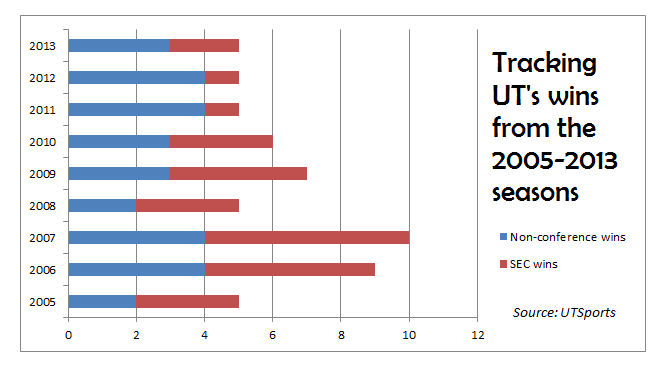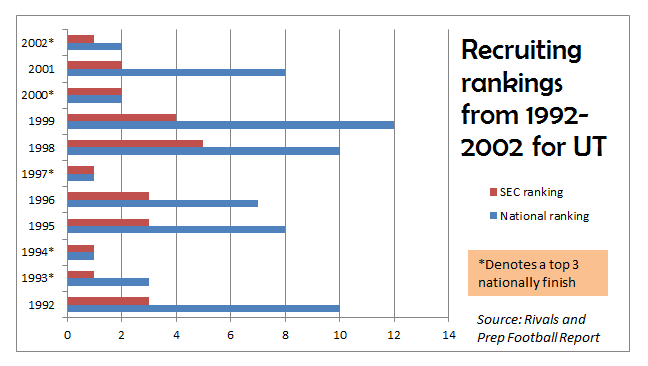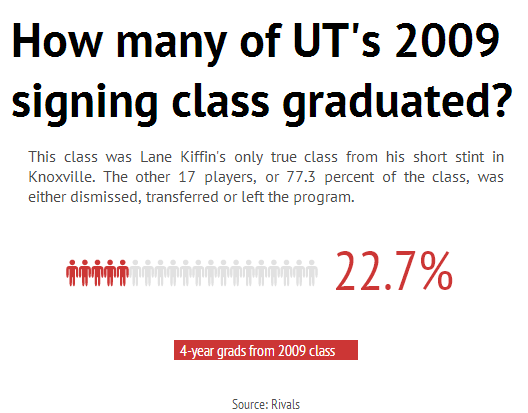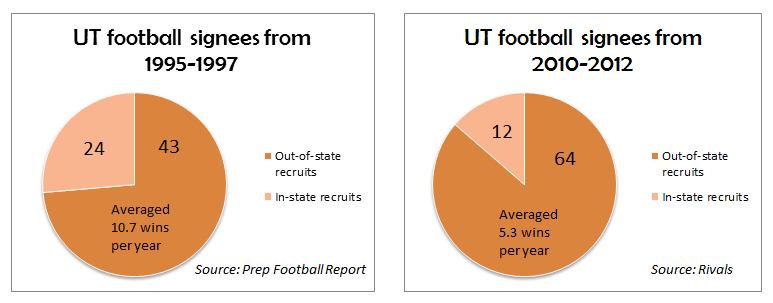As he prepared to finally answer the long-winded question, a small, reassuring grin crept onto his face, as if to say, “I got this one.”
The response in its entirety seemed to confirm his poised demeanor.
“We’re working to be the best,” Tennessee head coach Butch Jones said at his introductory press conference on Dec. 7, 2012. “We’re working to be number one every day.
“…This program has done it, and we’ll do it again.”

Once unanimously considered one of college football’s perennial powerhouses, the UT gridiron product yearned for Saturdays in the fall. With a raucous game day atmosphere thriving on both land and water, the Volunteers had established an eccentric and hostile environment that could morph Knoxville into a sea of orange on command.
From 1990 to 2004, UT averaged nearly 10 victories a year, produced seven double-digit-win seasons and was never absent from the postseason, winning eight of the 15 bowl games played during that time frame.
Three conference titles and four SEC championship game appearances were littered throughout the 15-year span — the climactic moment surfacing when UT navigated through the 1998 season unscathed, racking up a 13-0 record and the program’s first undisputed National Title since 1951.
But then — after this particular stretch concluded with the Vols punishing Texas A&M 38-7 in the 2005 Cotton Bowl — things began to shift.
It happened over time, but the change infected the program tremendously, triggering an all-out free fall down to unexplored levels of mediocrity. In the nine years (2005-13) immediately after the Aggie rout, the Vols’ average season-win total plummeted to a little more than six a year, causing the Knoxville faithful to experience four postseason-free seasons.

One year of double-digit victories. One year with a SEC title-game berth. One year with a bowl win.
And three coaching changes.
So given the multitude of football success produced in recent history, why exactly did the final part of Jones’ response need to be in past tense? This program has clearly “done it,” but why specifically is it not still “doing it”?
Recruiting breakdown

The Daily Beacon
Derek Dooley wanted to make sure everyone tuning in knew this statement was important.
So as the emphatic words rolled off his tongue, the ex-Tennessee head football coach repeatedly tapped his middle finger on the table, indicating this proclamation of satisfaction should be bolded and underlined.
“This is the best that I have felt, as far as the future of our program and where we are headed, in the 24 months that I have been on the job,” Dooley said on Feb. 1, 2012, at his National Signing Day press conference. “It is a good day, men.”
With both confidence and assurance pouring out of Dooley’s words, his declaration didn’t appear to have any lingering particles of the prior campaign — an all-around dismal season, which ended with UT’s first loss to Kentucky in nearly 30 years.
But while certain elements of the 2012 signing class did boast some cause for optimism — most notably former first-round draft pick Cordarrelle Paterson and current NFL defensive tackle prospect Daniel McCullers — the group as a whole finished just 17th in the nation according to Rivals.com.
In the nine-year span following the Texas A&M win (2005-13), the 2012 lot — ultimately Dooley’s worst recruiting haul in terms of rankings — was one of five classes to fall outside of Rivals’ top-10.
The lowest point of that stretch came in 2008, when despite coming off a SEC championship game appearance and an Outback Bowl victory over Wisconsin the previous year; ex-UT head coach Phillip Fulmer could only muster the 35th-best class in the country.
Ultimately, it was the last group he ever constructed as Fulmer was fired in Nov. 2008 following UT’s second losing season in four years. His final recruiting imprint was fifth-worst in the SEC — many miles away from where the Vols lived during most of Fulmer’s 17-year head coaching tenure.
From 1992-2004, UT consistently stayed perched high atop the recruiting rankings, gazing down below at a bevy of conference foes.
To further analyze that 13-year period, Rivals rankings, which formed in 1998 but only has archives dating back to 2000, was implemented for signing classes 2000-04, and Tom Lemming — a former ESPN recruiting analyst who now produces yearly rankings for his own publication, Prep Football Report — was used to rank signing classes 1992-99.
According to those specifics, the Vols churned out top-10 classes in all but three seasons (1999, 2003 and 2004), were ranked No. 1 or No. 2 four different times (1994, 1997, 2000 and 2002) and finished third or better in the SEC nine out of the 13 seasons.

“It really hasn’t changed,” said UT defensive backs coach Willie Martinez on the importance and development of SEC recruiting. “It is the same as all. The great thing about it is we are at a great institution, and that gives us the opportunity to recruit the best of the best.”
Bring it home

The Daily Beacon
The last three conference champions — all of which made it to the BCS National Championship Game as well — placed a heavy emphasis on owning their home state in rugged battle that is SEC recruiting.
In 2013, 41 percent (47-of-115) of Auburn’s roster was homegrown talent. The previous season, the Crimson Tide had 42 percent (49-of-116) of its team come from the state of Alabama. And in 2011, LSU topped them both, producing a roster that was 55 percent (54-of-92) Bayou State natives.
And like his fellow SEC coaches had done before him, Jones acknowledged the blueprint and understood the importance of in-state recruiting almost immediately,
“Let me make no mistake that we are going to win first and foremost with the great state of Tennessee,” Jones said on Dec. 7, 2012. “We have tremendous high school coaches in this state. We are the state institution, and we will own our state. We are going to be at every high school in the state, and our players are going to understand what is to wear the power ‘T.’ They’re going to understand what it is to represent their home institution.”
However, in Dooley’s tenure (2010-12), the Vols struggled mightily with in-state recruiting, signing only 16 percent (12-of-76) of its prospects from inside the borders of Tennessee.
That trend, nevertheless, did change drastically in Jones’ first year at the helm as 27 percent (6-of-22) of UT’s 2013 signing class were homegrown products — the highest one-year percentage since Lane Kiffin inked the exact same ratio in 2009.

“Well I think that we’re going to have great relationships in this state because we’re going to recruit this state well,” tight ends coach Mark Elder said on Feb. 6, 2013, at UT’s National Signing Day press conference. “We’re going to put our emphasis on this state, and we’ve got great people on this staff.
“So looking forward, I mean it’s going to be a great relationship within the state. I think the football here is really good, you can certainly sign a number of guys in the state and win championships with the guys in the state.”
That method was certainly implemented during the Vols’ rise to national prominence. From 1994-2004, Fulmer and his staff signed 60 in-state prospects, including 24 in a three-year span (1995-97).

And as to UT’s on-field performance in those three years where in-state recruiting was the most prevalent? A 32-5 overall record with double-digit wins in each season, as well as an SEC title and a BCS bowl appearance.
“Every great program starts with securing its home state,” Jones said on Feb. 5 after signing the highest percentage (32 percent) of in-state prospects at UT since 2007. “And we have to do that each and every year, and I am very excited to be able to do that this year.”
